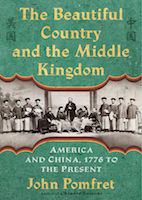John Pomfret was a longtime, award-winning correspondent with The Washington Post. He covered big wars and small in Afghanistan, Bosnia, Congo, Sri Lanka, Iraq, southwestern Turkey, and northeastern Iran. Pomfret spent seven years covering China—one in the late 1980s during the Tiananmen Square protests, and then from 1998 until the end of 2003 as the Bureau Chief for The Washington Post in Beijing. Returning to the United States in 2004, Pomfret was the paper’s West Coast Bureau Chief for two years before being appointed the Editor of its Outlook section, the Post’s weekly commentary section, which he ran from 2007 until September 2009. Pomfret moved back to China in 2011 to undertake research funded by a Fulbright grant and the Smith Richardson Foundation for his new book The Beautiful Country and the Middle Kingdom: America and China, 1776 to the Present.
Pomfret speaks, reads, and writes Mandarin, having spent two years at Nanjing University in the early 1980s as part of one of the first groups of American students to study in China. He has been a bartender in Paris and practiced Judo in Japan. He studied at Stanford University.
In 2003, Pomfret was awarded the Osborne Elliot Award for the best coverage of Asia by the Asia Society. In 2007, he was awarded the Shorenstein Award from Harvard and Stanford universities for his lifetime coverage of Asia. In 2011, he was awarded the Weintal Award from Georgetown University for diplomatic coverage.
He is also the author of the critically-acclaimed Chinese Lessons: Five Classmates and the Story of the New China.







